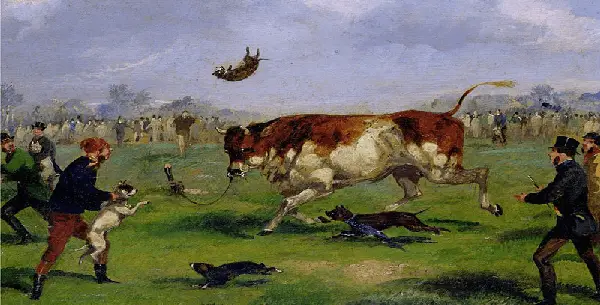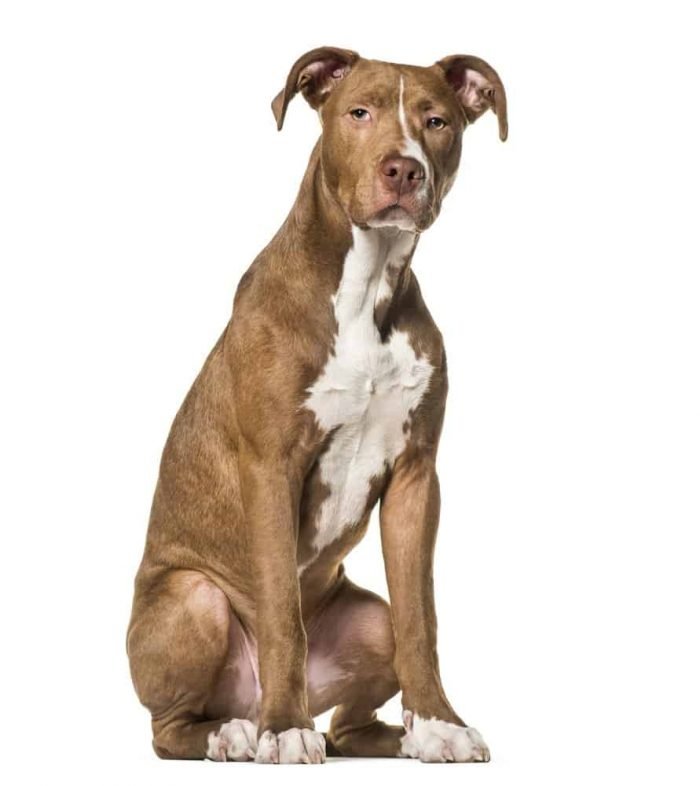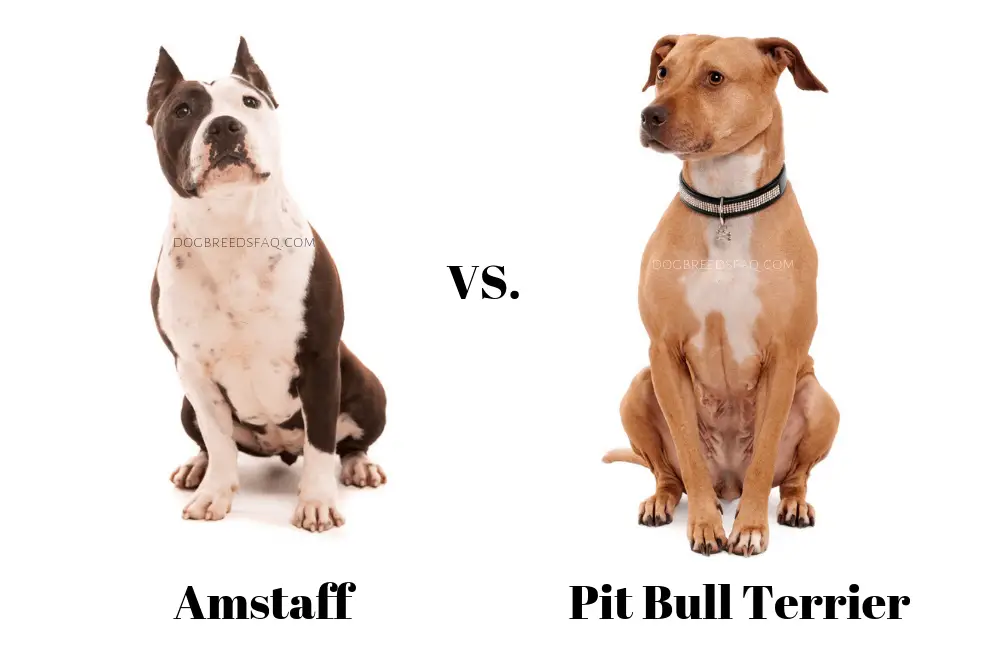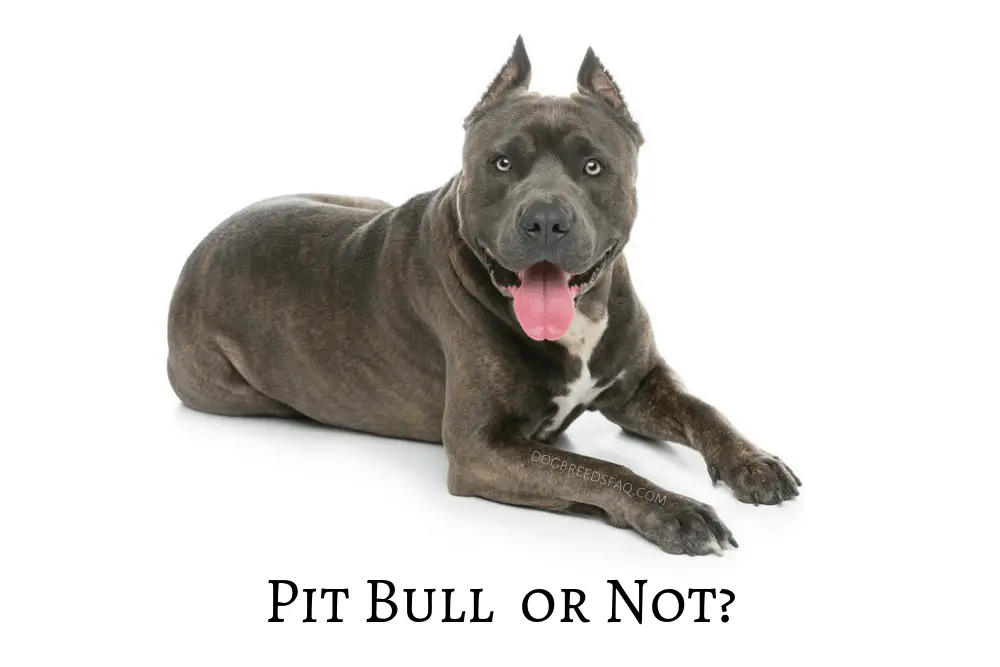Is the American Staffordshire Terrier a pit bull?
The American Staffordshire Terrier (affectionately shortened to Am Staff) is considered a “pit bull.” Although with many similarities, it is separate and distinct from its cousin breed, the American Pit Bull Terrier.
The lack of understanding around this breed should come as no surprise.
Are you confused?
Don’t worry.
Most of the confusion comes from a misconception of the term “pit bull.”
Read on to learn more about:
- what a “pit bull” really is
- how the Am Staff and the American Pit Bull Terrier fall into that category
- what makes all three of them different.
What Breed Is The Pit Bull?
None! And also many.
Okay, okay, that’s not very helpful.
But figuring out what dog counts as a pit bull is difficult because many people misunderstand what a pit bull is.
A common error is to believe that the term “pit bull” [1] refers to a specific breed. Still, the term refers to an ambiguous grouping of dogs or an umbrella term that includes several breeds, including the Am Staff and the American Pit Bull Terrier, the American Bulldog, the Staffordshire Bull Terrier, American Bully, and more.
These dogs are all descendants of cross-bred bulldogs and terriers, with origins in the 1800s in England.
Due to the term’s ambiguity, mixed dogs that share some of the more distinctive morphological features of the pedigree breeds in the pit bull type may also be labeled as pit bulls.
Mutts may also be considered pit bulls, demonstrating how broad the term is and how many dogs it may cover.
Why Are They Called Pit Bulls?

The “pit” part comes from an activity in which these dogs were bred for ratting.
In ratting, two dogs were placed in a pit with loosed rats, and the winner of the competition was the dog that could kill or trap more rats than their opponent in a set amount of time.
These kinds of tournaments served as precursors to the more violent and dangerous fighting rings that pit bulls later became known for and are characterized by today.
Like bulldogs, the “bull” part of a pit bull comes from their history of baiting bulls for sport.
All the bully breeds were used to bait large animals in this way—and this often also happened in a pit, which further contributes to the pit bull name.
What Is A True Pit Bull?

While some would say that pit bulls can refer to a fluid category of dogs, as discussed above, others would argue that the only true pit bull is the American Pit Bull Terrier—the only breed with the term “pit bull” in its name. (The other dogs commonly referred to as pit bulls, on the other hand, would more accurately be labeled as terriers.)
This poses a big problem for staunch defenders of the American Pit Bull Terrier.
What is the big deal, you may ask, about using the term pit bull to refer to dogs that aren’t American Pit Bull Terriers?
Well, believe it or not, it comes down to the law.
American Pit Bull Terriers have gained a bad reputation as aggressive and dangerous fighting dogs, and legislation has been put in place to specifically target their use in illegal fighting rings.
Protective owners will tell you that the misunderstanding between the American Pit Bull Terrier as a breed and the term “pit bull” as a name for a group of breeds—both purebred and otherwise—has led to even further damage against the breed’s reputation.
By lumping the American Pit Bull Terrier together with other dogs that share some of its morphological traits, public perception conflates violent and aggressive behaviors and incidents with dogs they should not be attributed to.
Attributing dog attacks from other breeds, mixed and pure, to American Pit Bull Terriers skews the numbers against them and damages their reputations.
If these numbers ever get high enough, it may be enough to encourage legislators to ban the breed.
In these statistics, American Pit Bull Terrier supporters oppose grouping together pit bull-type dogs as they paint the American Pit Bull Terrier as being more aggressive than research shows it is.
For the fiercest supporters of the American Pit Bull Terrier, it is the only true pit bull.
They oppose “pit bull” as an umbrella term that captures other breeds in its category. In their eyes, if it’s not an American Pit Bull Terrier, it is not a pit bull at all.
American Staffordshire Terrier vs. Pit Bull Difference

The confusion over whether a dog is an Am Staff or an American Pit Bull Terrier comes mainly from the lack of clarity around terms discussed throughout this article.
There is no breed known as the “pit bull”; instead, that is a descriptor of a group of breeds, including the Am Staff, the American Pit Bull Terrier, Staffordshire Bull terrier, and more.
So is the Am Staff a pit bull?
Technically yes, but the terms aren’t interchangeable.
It still varies from the American Pit Bull Terrier, and both breeds are commonly accepted as belonging to the pit bulldog type.
Temperamentally, both Am Staffs and American Pit Bull Terriers share loyal and energetic personalities, but Pit Bull Terriers tend to be more aggressive than their Am Staff counterparts.
Paired with their larger size, this can make them appear more intimidating than Am Staffs, although realistically, the two breeds share far more than they differ.
In terms of physical differences, there are slight but notable variations between the two breeds.
The most significant difference is that size: because the Am Staff was taken out of the pit earlier, they are markedly smaller than their Pit Bull Terrier cousins.
Even with the size difference, the wide allowable variation in color, coat, and musculature in both breeds can make it very difficult to distinguish them from one another—even for those trained to do so.
Perhaps the difficulty of telling these breeds apart should come as no surprise, given their shared roots.
Both of them are quite modern dogs in the grand scheme of things. Even DNA testing can be inconclusive when telling the two apart—that’s how close their diverging paths are.
Regardless, though, of what physically distinguishes the Am Staff from the American Pit Bull Terrier, there is a least one major difference by name: one breed (the Am Staff) is recognized by the American Kennel Club and can compete in all of its events; the other (the Pit Bull Terrier) is not.
There is also the difference of heritage: while the Am Staff has not been known as a fighting dog for some time now, the American Pit Bull Terrier continues to be used in illegal matches to this day.
This reputation has made new potential owners wary of adopting the latter, and Pit Bull Terriers are one of the most commonly rescued breeds in the country.
American Staffordshire Terrier vs Pitbull Differences Chart
| Feature/Characteristic | American Staffordshire Terrier (AmStaff) | American Pit Bull Terrier (APBT) |
|---|---|---|
| Origin | United States | United States |
| Size | Medium | Medium to Large |
| Weight | 40-70 lbs (18-31 kg) depending on gender | 30-85 lbs (13.6-38.5 kg) depending on gender and individual genetics |
| Height | 17-19 inches (43-48 cm) | 17-21 inches (43-53 cm) |
| Lifespan | 12-16 years | 12-16 years |
| Coat | Short and smooth | Short and smooth |
| Color Varieties | Wide range including brindle, black, blue, fawn, white, and combinations | Wide range including brindle, black, red, fawn, blue, white, and combinations |
| Temperament | Loyal, friendly, confident, and good-natured | Loyal, affectionate, confident, and gentle with family |
| Exercise Needs | High | High |
| Training | Highly trainable but requires consistency | Highly trainable but requires a firm hand |
| Good with Children | Yes, with proper socialization and training | Generally yes, but early socialization is crucial |
| Health Concerns | Hip dysplasia, skin allergies, and cardiac issues | Hip dysplasia, heart disease, and hereditary cataracts |
Is The AmStaff or The Pit Bull Terrier Right For You?
Both of these breeds have received a bad rap, but none of it is deserved.
Under abusive hands, any dog can become a monster, but these pit bulls are naturally friendly and protective. It doesn’t take much to reignite their ancestral nanny instincts!
If you’re thinking about either, and you have small children, consider getting younger dogs so they can grow up together.
Unfortunately, due to their ongoing presence in illegal fighting rings, pit bull breeds can have questionable origins, so make sure you’re adopting your American Pit Bull Terrier or American Staffordshire Terrier puppies from a breeder you’ve researched and trust.
But don’t let their bad reputation turn you off; both Am Staffs and American Pit Bull Terriers add a lot to a family—each in their unique way.
Do you love this breed?
Check Out More Pit Bull Breeds articles below:
References:
1. [^] “Pit Bull.” Wikipedia, Wikimedia Foundation, 19 Aug. 2019, https://en.wikipedia.org/wiki/Pit_bull.


The blanket term “Pit Bull” should be considered a derogatory slur as it most commonly is used for the intent of discrimination. There is absolutely no scientific support behind usage of this so-called “type” labeling, it is nothing more than a construct of human opinion (and daresay, agenda).
However, if American Pit Bull Terrier owners insist on their claim to the “pit bull” moniker then by all means they should have every right to it.
For me, the fact that the Staffordshire (English and American) is included under this umbrella term is outrageous and highly offensive. This article even demonstrates information to support this claim in that it clearly identifies the “AmStaff” as less aggressive and similar claims can be easily found in most related publications. It’s also mentioned that the AKC recognizes the Staffordshire breeds yet continue to deny the American Pit Bull Terrier and has had a longstanding issue with accepting “pit bulls” for the better part of a century (and long before pit bulls were demonized as they are today). In my research I have learned that the United States is the ONLY country in the entire world that considers a Staffordshire to be a “pit bull”.
By broadly designating no less than 5 various dog breeds as well as all mixed breed dogs that may resemble having “bully” characteristics (even if merely alleged or assumed by practically anyone, including those without any knowledge or experience with a “pit bull”) it allows any data attributed to “pit bulls” to be targeted at every single dog burdened with the label. Outside of being called a pit bull, there is little or no actual association between the breeds. Imagine if we did similar to humans. It would be like holding the entire continent of Asia accountable for North Korea’s nuclear weapons simply due to geography, while completely disregarding everything else (i.e. political ideology, genetics, economics, religion, etc.). I doubt many would argue that this sort of behavior is typically considered racism and prejudice, which is widely frowned upon in every corner of the world today.
Ironically, multiple studies done in very recent years actually indicates “pit bulls” to be one of the least aggressive dogs, posing almost no danger to humans (but can tend to be aggressive towards other dogs or animals).
A few years ago, one reporter found themselves looking into keyword trends in media publications during the 1980s. Two phrases stood out for trending and showed a practically identical spike in usage: Crack Cocaine and Pit Bulls …in reading through news articles, the reporter learned that as crime rose during the crack epidemic many were adopting pit bulls for guard dogs. They also found that papers were demonizing pit bulls with unsubstantiated claims such as a “will to kill unrivaled by anything else in nature” and that they have a bite force greater than 740 pounds of pressure per square inch (40 years later and there is still no credible source to support such a claim). The LA Times insisted pit bulls were monsters calling a dog “by name only” and even a New York Times article advised that pit bulls were trained as puppies by killing kittens and other puppies.
Obviously, most of the aggressive “pit bulls” were products of their owners and with having such a reputation established during the 70s and 80s they became sought after for such purpose (including actual Pit Bull Terriers for dog fighting).
By this time, the falsified media sensationalism and growing popularity for aggressive and intimidating dogs had solidified the “pit bull” designation among the mainstream. With such open disregard for actual facts, it sadly comes as little surprise that Americans are so willing to label such a vast array of dog breeds as “pit bulls” just as nonchalantly as any insult or slur peppered throughout our lexicon.
Fast forward to today, and things haven’t changed much. While pit bull adoption and rescue has become popular, even if well trained and socialized it’s evident many people still enjoy the notorious pit bull reputation. However, “cool” as they may think that is, they only serve to enable and perpetuate the dangers such reputation poses for the innocent American Pit Bull Terrier, American Staffordshire Bull Terrier, (English) Staffordshire Bull Terrier, American Bully, and the English Bull Terrier (note: some sources also claim the American Bulldog …whatever. It’s only in America and even America can never agree with itself so I call bullshit on the whole thing).
Excellent comment!
You must be thinking of “lock jaw” which is actually a myth!
Your comment comes across as very ignorant of actual facts and open mindedness. But as @Sinjin Yoon stated, it’s no surprise due to the “falsified media sensationalism”.
This was meant for reply to Chris’ comment posted at Dec 30, 2021 @ 14:36
They are both the same. Dangerous by definition and in the fact that they won’t release their prey. End of discussion. These breeds should be banned.
Thank you for sharing your opinion Chris.
Chris, your opinion is just that, your opinion…. Your lack of actual knowledge is very evident. Please tell me the dog breed with the most reported dog bites? Now tell me how many people you actually know that have had a bad experience with an Amstaff? To say they are dangerous by definition is the same as saying you are stupid by definition.
I personally own a purebred American Staffy and you actually have the pictures reversed. Amstaff owners usually don’t crop the ears and they also lack the “Bully Breed” aspect therefore are much thinner and less bulky. My female weighs 60lbs. and is 18” at the shoulder…. Amstaff’s also have a longer snout.